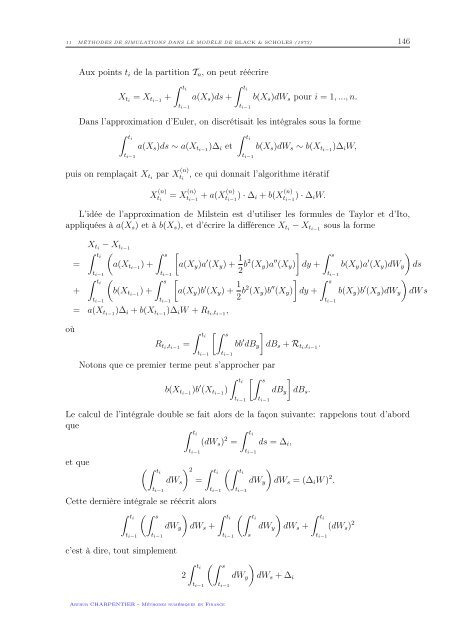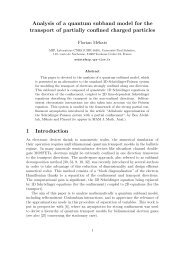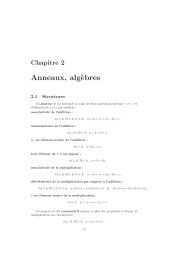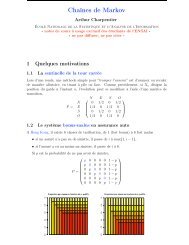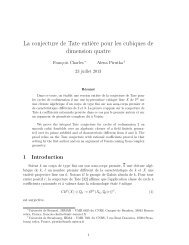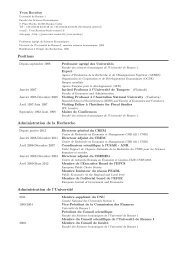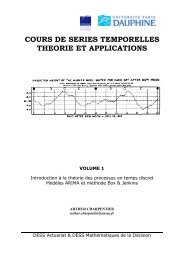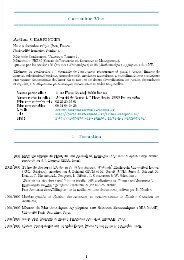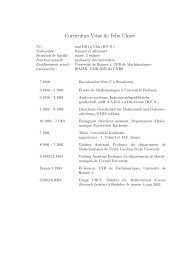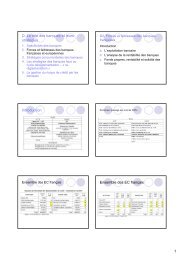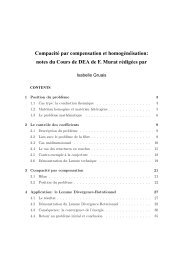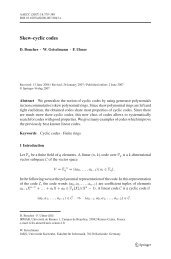Méthodes numériques en finance
Méthodes numériques en finance
Méthodes numériques en finance
Create successful ePaper yourself
Turn your PDF publications into a flip-book with our unique Google optimized e-Paper software.
11 MÉTHODES DE SIMULATIONS DANS LE MODÈLE DE BLACK & SCHOLES (1973) 146<br />
Aux points t i de la partition T n , on peut réécrire<br />
X ti = X ti−1 +<br />
∫ ti<br />
∫ ti<br />
a(X s )ds + b(X s )dW s pour i = 1, ..., n.<br />
t i−1 t i−1<br />
Dans l’approximation d’Euler, on discrétisait les intégrales sous la forme<br />
∫ ti<br />
t i−1<br />
a(X s )ds ∼ a(X ti−1 )∆ i et<br />
∫ ti<br />
t i−1<br />
b(X s )dW s ∼ b(X ti−1 )∆ i W,<br />
puis on remplaçait X ti<br />
par X (n)<br />
t i<br />
, ce qui donnait l’algorithme itératif<br />
X (n)<br />
t i<br />
= X (n)<br />
t i−1<br />
+ a(X (n)<br />
t i−1<br />
) · ∆ i + b(X (n)<br />
t i−1<br />
) · ∆ i W.<br />
L’idée de l’approximation de Milstein est d’utiliser les formules de Taylor et d’Ito,<br />
appliquées à a(X s ) et à b(X s ), et d’écrire la différ<strong>en</strong>ce X ti − X ti−1 sous la forme<br />
=<br />
+<br />
X ti − X ti−1<br />
∫ ti<br />
(<br />
t i−1<br />
∫ ti<br />
(<br />
t i−1<br />
a(X ti−1 ) +<br />
b(X ti−1 ) +<br />
∫ s<br />
[<br />
t i−1<br />
∫ s<br />
t i−1<br />
[<br />
= a(X ti−1 )∆ i + b(X ti−1 )∆ i W + R ti ,t i−1<br />
,<br />
a(X y )a ′ (X y ) + 1 ]<br />
2 b2 (X y )a ′′ (X y )<br />
a(X y )b ′ (X y ) + 1 ]<br />
2 b2 (X y )b ′′ (X y )<br />
dy +<br />
dy +<br />
∫ s<br />
)<br />
b(X y )a ′ (X y )dW y ds<br />
t i−1<br />
)<br />
b(X y )b ′ (X y )dW y dW s<br />
t i−1<br />
∫ s<br />
où<br />
R ti ,t i−1<br />
=<br />
∫ ti<br />
[∫ s<br />
]<br />
bb ′ dB y dB s + R ti ,t i−1<br />
.<br />
t i−1 t i−1<br />
Notons que ce premier terme peut s’approcher par<br />
b(X ti−1 )b ′ (X ti−1 )<br />
∫ ti<br />
[∫ s<br />
]<br />
dB y dB s .<br />
t i−1 t i−1<br />
Le calcul de l’intégrale double se fait alors de la façon suivante: rappelons tout d’abord<br />
que<br />
et que<br />
(∫ ti<br />
∫ ti<br />
t i−1<br />
dW s<br />
) 2<br />
=<br />
∫ ti<br />
(dW s ) 2 = ds = ∆ i ,<br />
t i−1 t i−1<br />
∫ ti<br />
Cette dernière intégrale se réécrit alors<br />
∫ ti<br />
(∫ s<br />
)<br />
dW y dW s +<br />
t i−1 t i−1<br />
(∫ ti<br />
)<br />
dW y dW s = (∆ i W ) 2 .<br />
t i−1 t i−1<br />
∫ ti<br />
(∫ ti<br />
)<br />
dW y dW s +<br />
t i−1<br />
s<br />
∫ ti<br />
t i−1<br />
(dW s ) 2<br />
c’est à dire, tout simplem<strong>en</strong>t<br />
∫ ti<br />
(∫ s<br />
)<br />
2<br />
dW y dW s + ∆ i<br />
t i−1 t i−1<br />
Arthur CHARPENTIER - Méthodes numériques <strong>en</strong> Finance


